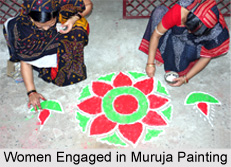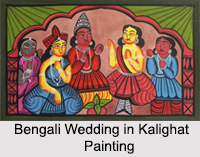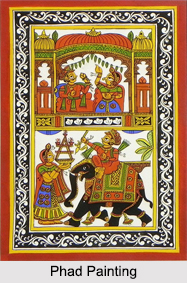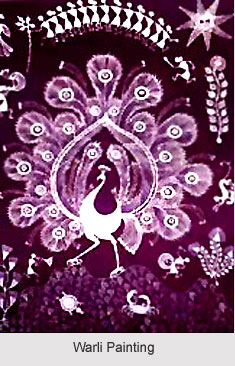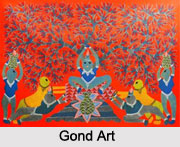 Genres of Indian tribal paintings are based on the type of motifs used; surface on which it is drawn and the regions where it is common. Wall painting represents the tradition of painting with rich geometrical patterns, men, animals and symbols. Front wall of the hut is the most common site for wall paintings. The abstract paintings are generally drawn either at the lower or upper portions of the wall or around the door corners. Representational or naturalistic forms are sketched at a certain height from the level of the earth, either in the centre of the wall or on both the sides of the door. The representative figures are generally of animals, birds or human beings which are drawn singly on the wall.
Genres of Indian tribal paintings are based on the type of motifs used; surface on which it is drawn and the regions where it is common. Wall painting represents the tradition of painting with rich geometrical patterns, men, animals and symbols. Front wall of the hut is the most common site for wall paintings. The abstract paintings are generally drawn either at the lower or upper portions of the wall or around the door corners. Representational or naturalistic forms are sketched at a certain height from the level of the earth, either in the centre of the wall or on both the sides of the door. The representative figures are generally of animals, birds or human beings which are drawn singly on the wall.
Different Genres of Tribal Paintings
There are different genres of Indian tribal paintings and these are as follows:
Symbolic Forms of Indian Tribal Paintings
The factors that limit the tribal artists would be the art motifs of culture. He is unlikely to invent an entirely new motif, however would use those with which he is familiar. There are many paintings which are based on some common symbolic forms. These forms are seen in the interiors. They have made these forms in simple suggestive manner. The varieties of forms are used to represent persons, animals and birds in a region.
Representative Forms of Indian Tribal Paintings
Most of the tribal paintings are representative in nature. The term implies that the work is not affected by its form alone, sometimes even primarily by its content too. These paintings are spontaneously made and are based on memory.
From the representational point of view few of the animal paintings are remarkable. These are singly drawn on the wall in different colours and by different artists and they have some common characteristics. There are examples of narrative paintings of representative art too.
Naturalistic Forms of Indian Tribal Paintings
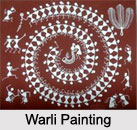 There are examples of naturalistic work done by the skilled tribal artists. These are visible on the walls of houses in road-side villages. In this category human form, animals and nature are depicted. Colouring of relief work is not very common but there are some examples in which similar efforts have been made.
There are examples of naturalistic work done by the skilled tribal artists. These are visible on the walls of houses in road-side villages. In this category human form, animals and nature are depicted. Colouring of relief work is not very common but there are some examples in which similar efforts have been made.
Abstract Forms of Indian Tribal Paintings
Abstraction is the common and mostly practiced mode of painting. The abstraction here is referred to the sense of a synthesis of geometrical elements. There is no model in nature and no pre-existing visual image exists. There are many tendencies in the abstract decoration of huts. In most of the road-side huts or in the interiors the abstract decoration has a certain trend that is followed.
Types of Tribal Art Paintings
There are different types Tribal Art which are popular and these are -
Warli: Everything about it is down-to-earth and soothing. The Warlis are an original tribe residing around the hilly and coastal areas of Maharashtra and Gujarat boundary.
Madhubani: Mithala painting is one of the most well-liked a folk arts and an art form passed down for generations from mother to daughter in the northern part of Bihar. The paintings are generally mythical, covering stories of Ram-Sita, Krishna-Radha, Ganesha and so on to a floral, animal and bird decoration backgrounds with barely any empty space left.
Gond: The Gond tribe in Madhya Pradesh created these bold, brightly coloured paintings, depicting mostly flora and fauna. The colours come from charcoal, cow dung, leaves and coloured soil.
Cheriyal Scrolls: This disappearing art form is practised by the Nakashi family only, where it has been passed down for many generations. The tradition of long scrolls and Kalamkari art influenced the Cheriyal scrolls, a much more stylised side of Nakashi art.
Bhil: Originating from the Jhabua district of Madhya Pradesh and Bhil people think paintings are the best form of contribution prayers. Each painting is composed of numberless dots creating different patterns and each dot represents a deity as well as living organisms.
Pithora: Exercised by the Rathwa community from Gujarat and Madhya Pradesh, Pithora art follows a very parallel style to that of Bhil art. The paintings are characterized by seven horses expressive the seven hills that surround the area where the Rathwas reside.
Santhal paintings: The Santhal tribe has a distinctive technique of painting, which is well-known as Santhal paintings. The themes for these paintings are chosen from the natural surroundings or from the activities of everyday lives, such as a happy family, fields, dance, and quarrel, beating wife, gods and goddess.

